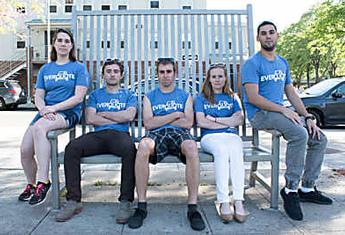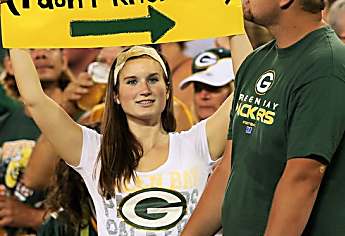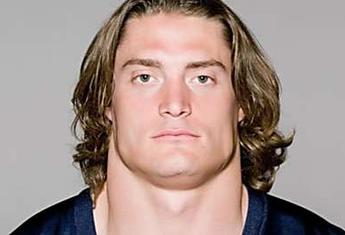Spartan game films bring back history
By Tom Corrigan - tcorrigan@aimmediamidwest.com

A screenshot of the Warner Brothers produced game film of the Portsmouth Spartans taking on the Chicago Bears at Wrigley Field.
As at least most natives probably know, Portsmouth truly once did host a genuine National Football League team. From 1930 to 1934, when the team was moved to Detroit and renamed the Lions, the Portsmouth Spartans were part of the fledgling NFL and played in what was Universal Stadium, now Spartan Stadium.
That Portsmouth was once part of the NFL is something that probably should not be forgotten, according to City Councilman Sean Dunne and retired Shawnee State University history professor John Lorentz. The pair spent at least part of the last roughly two years trying to find a way to preserve footage of two obviously aged game films of Spartan contests against the Chicago Bears and the New York Giants.
But more importantly than preserving the films, both Dunne and Lorentz hope the surfacing of the two films might aid in sparking a kind of Portsmouth renaissance.
“The past is present and informs the future. A strong awareness of the Portsmouth past is tied to our identity as a community and this abstraction is not merely an exercise of the mind but is linked to what actually will physically happen in the future,” Lorentz contends philosophically.
Essentially, Dunne, and perhaps especially Lorentz, see Portsmouth becoming a sort of cultural/historical/recreational hub, if you will. Lorentz says the basis of such a hub already is in place thanks to Shawnee State University and the Vern Riffe Center for the Performing Arts. He talked about Portsmouth becoming a magnet for arts and music.
“The amount and depth of local talents in this regard never ceases to amaze me” Lorentz said.
Both he and Dunne spoke further of creating a small-town sports hub, centered somewhat around the renovation of Spartan Stadium and Branch Rickey Park. Lorentz talked (and wrote in an email) about the potential of the flood wall murals becoming a tourist and biking destination far more so than they are today. He briefly touched on the potential of the Ohio Erie Canal locks still present in and around Portsmouth as full of potential as well. Lorentz argues Portsmouth never again will be a major manufacturing town. He said locals need to stop looking for some outside business to swoop in and be Portsmouth’s savior.
“It boils down to a hypothesis that I developed a long time ago which goes something like this: ‘Development in a community is not a function of money/economics alone, it involves creating and sustaining a public sense of things moving in the right direction.’ That is when entrepreneurs jump out of the woodwork,” Lorentz said.
Even as Lorentz and Dunne talked about the future, they also needed to touch on the past regarding those two Spartan game films. The story begins with George D. Selby, the original owner of the Selby Shoe Company in Portsmouth. Somehow Selby became the caretaker of the two game films. It’s not clear who shot the Giants game film but the Bears film obviously was made professionally. A large caption at the beginning declares it was created by Warner Brothers and appears to be a newsreel.
Incidentally, the Bears game was an away game played at Wrigley Field in Chicago on Nov. 8, 1931. The Giants game was a home contest ground out at Spartan Stadium, Sept. 25, 1932. The final score was: Spartans 7, Giants 0. The Spartans lost to the Bears 9-6. However, according to Wikipedia, at the end of the ‘32 season, with a record of 6-1-4, the Spartans tied for first place in the league with the Bears. That prompted what became known as the first NFL playoff game.
Blizzard conditions in Chicago meant the game was moved from Wrigley Field’s outdoor field to the indoor field at Chicago Stadium, which allowed for only an 80-yard field. The Bears came out on top, 9–0, on a touchdown pass from Bronko Nagurski to Red Grange. Because it was the NFL’s first playoff game, it could be said to cement the Spartans a place in NFL history.
After Selby’s death in 2004, Dunne said the game films went into the possession of his widow. For many years, they were stored in the family garage. Eventually, in a bad state of disrepair, the films were handed off to well-known Portsmouth radio personality Sam McKibben, apparently a big football fan, he said he held onto them for many years.
In the meantime, Lorentz, whose academic field was Middle Eastern history, somehow was gaining a name as a documentary filmmaker and an expert in local history. Working with his son Nathan, a professional filmmaker, Lorentz produced “Beyond These Walls: Building Community through Public Art.” The documentary focused on Portsmouth’s famed flood wall murals. Lorentz said his initial interest sprung from curiosity over why the murals never seem to suffer any graffiti problems. His ultimate answer to that conundrum kind of ties into his thoughts on community building.
Essentially, Lorentz concluded city residents are profoundly fond of the murals, which now grace what was essentially a prison wall enclosing one end of the city. Not incidentally, Lorentz notes the original wall did suffer from graffiti problems.
“Beyond These Walls” unexpectedly became somewhat of a hit and not just locally, winning national awards and airing on PBS. The film was so popular the Lorentz team produced a second video “River Voices,” a documentary on the 1937 flood, which of course led to the creation of the flood walls.
As Lorentz became somewhat of a local celebrity, McKibben interviewed him on numerous occasions. Somehow, the two lit on the topic of the NFL films in McKibben’s’ possession. As Lorentz was the film expert between the two, McKibben turned the movies over to him. It was at that point, Dunne entered the picture as Lorentz looked for a way to restore and preserve the films.
Dunne said their first stop was the NFL Hall of Fame in Canton, which Dunne hoped could hook them up with NFL Films. At first, hall officials were excited about the films and agreed to take them. Then they found out one of the films was a silver nitrate film, basically meaning it was coated with a hazardous substance. The hall was forced into declining to accept the films.
His next step took over a year, but Dunne said ultimately resulted in the films being accepted and catalogued into the Library of Congress. A long series of emails provided by Lorentz proves that process was anything but straightforward and simple. The nitrate film was especially a problem because of its extreme flammability. That film eventually was restored by a private firm in New Jersey.
For the future, Lorentz and his son are working on a new film focusing on Portsmouth’s Dreamland swimming pool. It may be completed sometime next year. In the meantime, Dunne has been working on publicizing the game films and hunting down money to restore and preserve Spartan Stadium among several other projects. He recently announced the procurement of a $2,000 Scioto Foundation grant to be used to remove graffiti from the stadium.
In the end, Lorentz pretty much summed things up. He insists Portsmouth has all the pieces in place to be vibrant again.
“What has been lacking is leadership and will. I believe that is changing. I see all sorts of positives out there which the populace as a whole has not yet perceived, but to refer back to my hypothesis, momentum is shifting and will gain stronger headway as it sinks in that things are no longer spiraling downwards but are moving in the right direction.”
The restored game films can be viewed on You Tube at www.youtube.com/results?search_query=portsmouth+spartans.






![[Pics] Missing Six-Year-Old Boy Found After 22 Hours, But Then They Realized Who Kept Him Company [Pics] Missing Six-Year-Old Boy Found After 22 Hours, But Then They Realized Who Kept Him Company](https://images.outbrainimg.com/transform/v3/eyJpdSI6ImY0OTg0MWEyMjA5M2MwMTdlNGI2ZTBhNTQzOWIwNzY5ZDQ1NTlkMjgyODY1ZDc2MDA2ZTViNTNiODA5MWZmYmEiLCJ3IjoyMzAsImgiOjE1NywiZCI6MS41LCJjcyI6MCwiZiI6MH0.jpg)



No comments:
Post a Comment